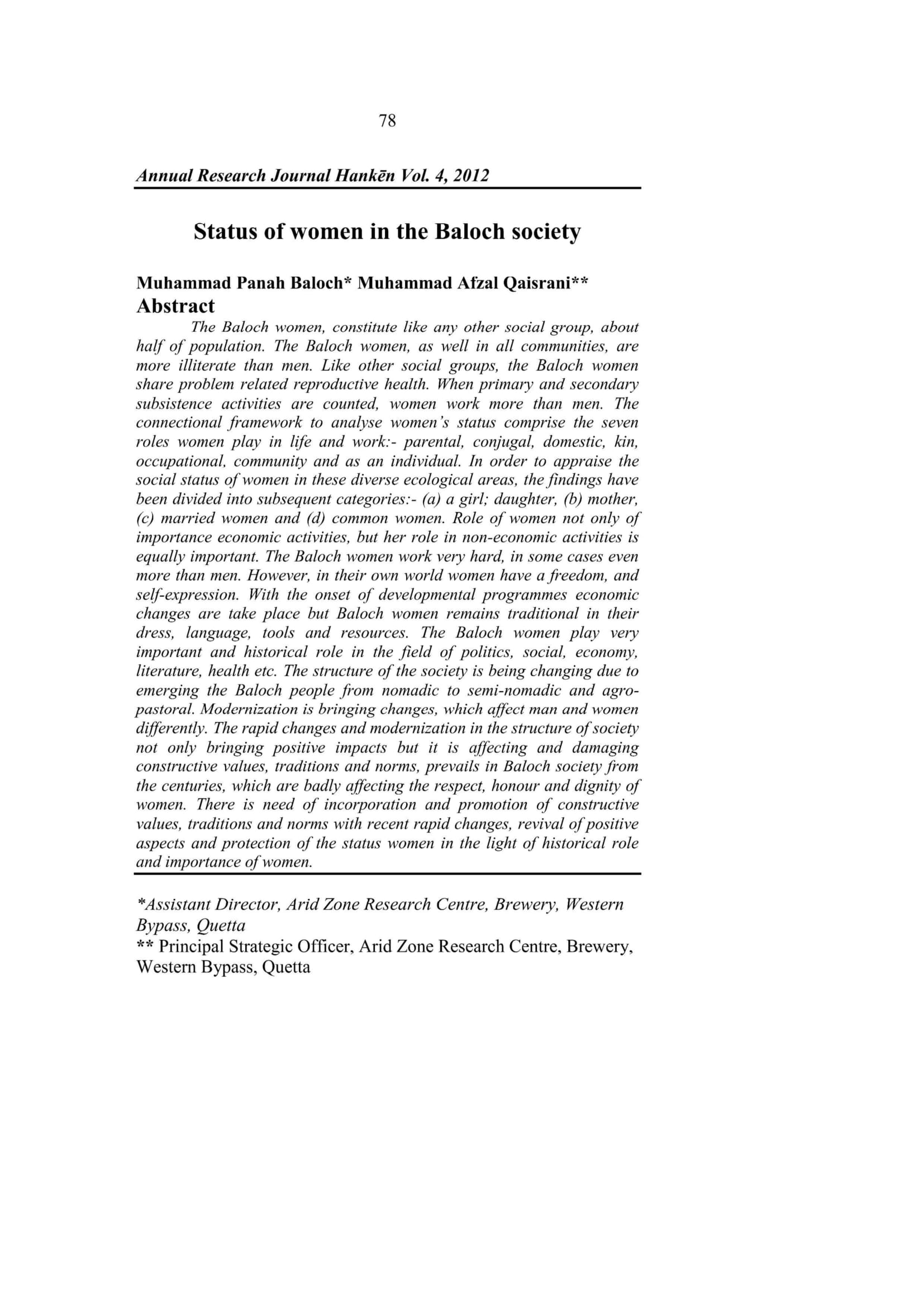Status of women in the Baloch society
Keywords:
population, communities, programmesAbstract
The Baloch women, constitute like any other social group, about half of population. The Baloch women, as well in all communities, are more illiterate than men. Like other social groups, the Baloch women share problem related reproductive health. When primary and secondary subsistence activities are counted, women work more than men. The connectional framework to analyse women’s status comprise the seven roles women play in life and work:- parental, conjugal, domestic, kin, occupational, community and as an individual. In order to appraise the social status of women in these diverse ecological areas, the findings have been divided into subsequent categories:- (a) a girl; daughter, (b) mother, (c) married women and (d) common women. Role of women not only of importance economic activities, but her role in non-economic activities is equally important. The Baloch women work very hard, in some cases even more than men. However, in their own world women have a freedom, and self-expression. With the onset of developmental programmes economic changes are take place but Baloch women remains traditional in their dress, language, tools and resources. The Baloch women play very important and historical role in the field of politics, social, economy, literature, health etc. The structure of the society is being changing due to emerging the Baloch people from nomadic to semi-nomadic and agro-pastoral. Modernization is bringing changes, which affect man and women differently. The rapid changes and modernization in the structure of society not only bringing positive impacts but it is affecting and damaging constructive values, traditions and norms, prevails in Baloch society from the centuries, which are badly affecting the respect, honour and dignity of women. There is need of incorporation and promotion of constructive values, traditions and norms with recent rapid changes, revival of positive aspects and protection of the status women in the light of historical role and importance of women.
References
Asser Abdul Qadir Shahwani, 1978. Aeena-e-Kharan. Balochi Academy, Quetta: 125
Asser Abdul Qadir Shahwani, 1978. Balochi Dunya, Multan
Asser Abdul Qadir Shahwani, 2005. Dialy Jang, Quetta:05-03-2005
District Gazetteer, 2004. District Gazetteer Series. Directorate of Archives, Balochistan, Quetta
Goldstein, Matthew (2002). "The Biological Roots of Heat-of-Passion Crimes and Honor Killings". Politics and the Life Sciences 21 (2): 31
Illich, I 1982, Gender. Pantheon Books, New York
Innayatullah Khan, 1987. The problems of greater Balochistan. Steiner Verlag Wiesbaden GMBH, Stuttgart.
M. L. Dames, 1988. Popular Poetries of the Baloches. Balochi Acedemy, Quetta:184
Mehmood. A. Shah, 2008. Aapbeeti Balochistan Beeti. Classic Publishers, Lahore.:214
Memon Abdul Hameed Sindhi, 1987. Sindh je Tarikh ja wikhrial warq. Mehran Academy, Karachi:68
Mir Gul Khan Naseer, 1990. Balochistan ki Kahani Shairon Ki Zibani. Balochi Academy, Quetta: 257
Mir Gul Khan Naseer, 1990. Balochistan ke Srahadi Chapamar. Mr. Reprints, Quetta:172-181
Mir Gul Khan Naseer, 2010. Tarikh-e-Balochistan. Kalat Publishers, Quetta: 20-21/117
Malik Muhmmad Saleh Lehri, 1955. Balochistan One unit Se Pehle, Faizullah Khan Baloch, Quetta:168
Muhammad Sardar Khan, 1988. Literary History of Balochis. Balochi Academy, Quetta,: 474-481
Naseer Dashti, 2008. The Cultural context of Health: A Baloch Perspective. Balochi Academy, Quetta, p. 137-138.
Shafiq,M., 2008. Analysis of the role of women in livestock of Balochistan. Pakistan. J. Agri. Soc.Sci.,4:18-22
Wahid Buzdar, 2012. Mahtak Balochi, July, 2012: 11


